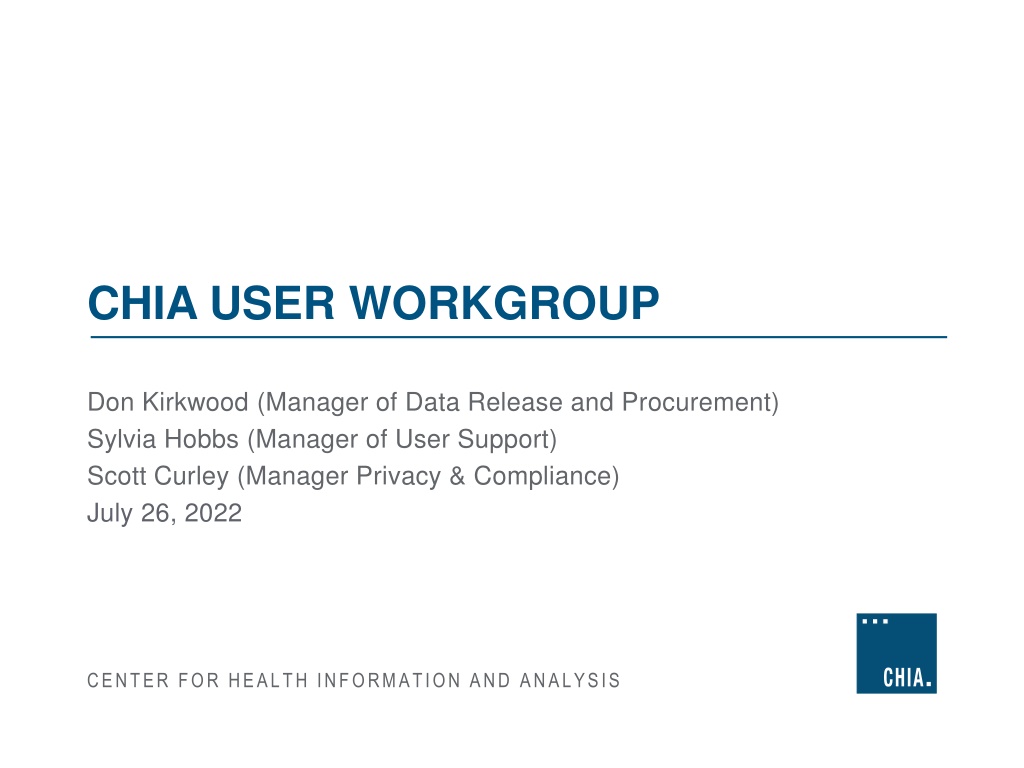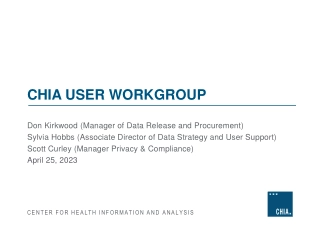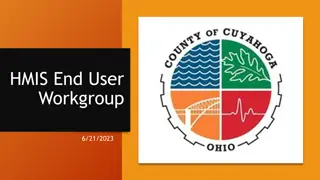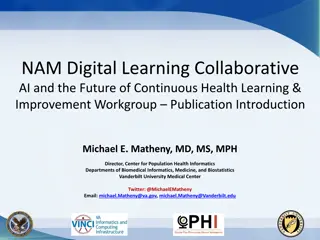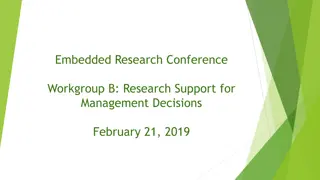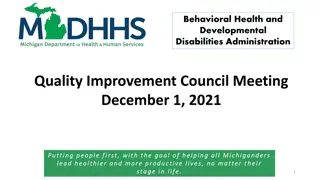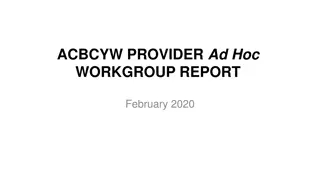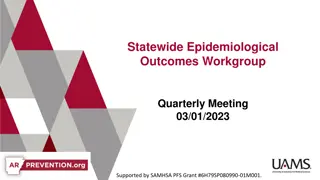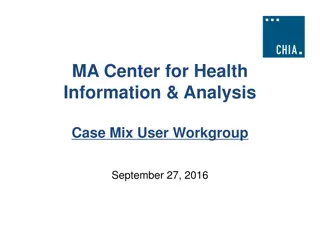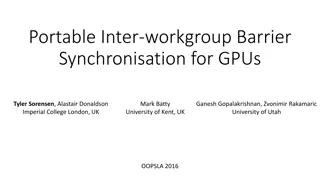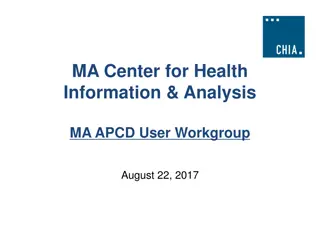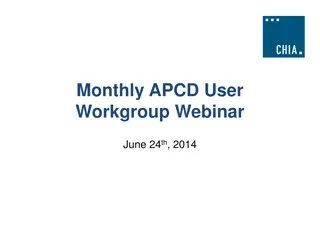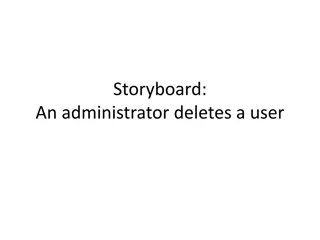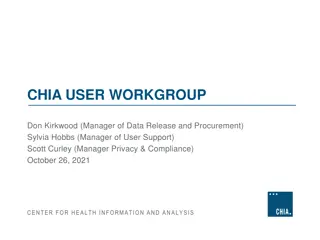CHIA USER WORKGROUP
Explore the latest updates from the CHIA User Workgroup meeting on July 26, 2022, featuring announcements on APCD Release, FY20 Case Mix Projections, User Support, and more. Learn about data availability, release timeframes, and website updates for users.
Download Presentation

Please find below an Image/Link to download the presentation.
The content on the website is provided AS IS for your information and personal use only. It may not be sold, licensed, or shared on other websites without obtaining consent from the author.If you encounter any issues during the download, it is possible that the publisher has removed the file from their server.
You are allowed to download the files provided on this website for personal or commercial use, subject to the condition that they are used lawfully. All files are the property of their respective owners.
The content on the website is provided AS IS for your information and personal use only. It may not be sold, licensed, or shared on other websites without obtaining consent from the author.
E N D
Presentation Transcript
CHIA USER WORKGROUP Don Kirkwood (Manager of Data Release and Procurement) Sylvia Hobbs (Manager of User Support) Scott Curley (Manager Privacy & Compliance) July 26, 2022 CENTER FOR HEALTH INFORMATION AND ANALYSIS
Agenda Announcements: APCD Release CY 2020 Updates FY20 Case Mix Release Projections Website Updates User Support Questions Updates to Case Mix Payer Coding Interfacility Transfers Mode of Transport Infant Race/Ethnicity Q&A 2 User Workgroup | CHIA User Support
MA APCD CY 2020 (Release 10.0) Available for request Applicants with approved projects that require updated APCD data (CY 2020 Data) should submit to CHIA a completed Exhibit B (Certificate of Continued Need and Compliance) of the Data Use Agreement. After submitting a completed Exhibit B you will receive an invoice (if applicable) for the requested data. Upon payment of the invoice the order for the data will be placed. CY 2020 Data includes data on services from January 2016 December 2020 with six months of claim runout. 3 User Workgroup | CHIA User Support
Case Mix FY21 Release *CURRENT* RELEASE TIMEFRAMES FOR EACH FILE: Inpatient (HIDD) Available for request Emergency Department (ED) August 2022 Outpatient Observation (OOD) Applicants with approved projects that require newly available year(s) of Case Mix Data (e.g., FY 19) should submit to CHIA a completed Exhibit B (Certificate of Continued Need and Compliance) of the Data Use Agreement. After submitting a completed Exhibit B you will receive an invoice (if applicable) for the requested data. Upon payment of the invoice the order for the data will be placed. September 2022 4 User Workgroup| CHIA User Support
Website Release Updates Updates on the production of APCD and Case Mix databases and status of data requests are now posted to CHIA s website! Aim #1 is to provide weekly or bi-weekly status update on CHIA data products as they are in development. Aim #2 is to provide applicants with information about expected fulfillment status for individual data requests. Request IDs will be communicated to Data Requestors via email. Please visit http://www.chiamass.gov/status-of-data-requests/ to see the current status of releases. User Workgroup| CHIA User Support 5
Payer Types Question Question: I understand in case mix the payer code is the health plan. In 2021, : I understand in case mix the payer code is the health plan. In 2021, there were fewer health plans associated with more payer types. Can you explain there were fewer health plans associated with more payer types. Can you explain the change in payer codes and their relationship to the type codes? the change in payer codes and their relationship to the type codes? Answer: In FY2021, CHIA reduced the number of case mix payer codes from 365 codes to 74 codes. The previous codes had combined health plan names with products. Also, the payer type codes were increased from 22 to 23, eliminating Blue Cross as a payer type (maintaining it under payer code health plans) and adding two new codes payer types for accountable care organization and senior care/integrate care organization (see Table 1 below). Detailed definitions of payment typology in PHDSC s User Guide for Payment Typology (see Figure 1 below). Table 1. FY2021 Change in Payer Types Figure 1. PHDSC s Payment Typology Guide 2021 Codes 0 1 2 3 4 5 Prior to 2021 0 1 2 3 4 5 6 7 8 9 PAYER TYPE DEFINITION Other Non-Managed Care Plans Self Pay Worker's Compensation Medicare Medicaid Other Government Payment Blue Cross 7 8 9 A B C D E F H J K N Q S T Z Other Commercial Insurance not listed elsewhere HMO Free Care Medicaid Accountable Care Organization Medicaid Managed Care/MCO Commercial Accountable Care Organization Commercial Managed Care PPO Medicare Managed Care (includes Medicare Advantage) Health Safety Net Point-of-Service Plan Exclusive Provider Organization None (Valid only for Secondary Payer) Commonwealth Care/ConnectorCare Plans Senior Care Option/Integrated Care Organization (SCO/ICO) Auto Insurance Dental Plans B C D E F H J K N Q Source: https://www.nahdo.org/sites/default/files/SourceofPaymentTypologyUsers GuideVersion8_December_18_2017.pdf T Z
Payer Types Answer (continued): For example, prior to 2021 in case mix data payer coding options, there were eight different coding options for the insurance carrier Fallon. In 2021, the codes for Fallon were consolidated under one coding option. See Figure 1 below. Consequently, you will see an increase in the use of payer type codes in FY2021 to distinguish the specific types of Fallon products for the one payer code. See Table 1 below. Figure 1. Consolidation of Fallon under one Coding Option in FY2021 Case Mix Prior to FY2021 FY2021 Fallon Community Health Plan Fallon POS Fallon Flex POS Fallon Major Medical - Indemnity Fallon Preferred Care - PPO Fallon MassHealth CarePlus Fallon ConnectorCare Fallon Health Plan Fallon Community Health Table 1. FY2017 - FY2021 Payer Codes for Fallon in Inpatient Hospital Discharge Data FY2017 HMO FY2018 HMO FY2019 FY2020 FY2021 HMO Commercial Managed Care HMO Commercial Managed Care Medicaid Managed Care Medicare Managed Care HMO Commercial Managed Care Medicaid Managed Care Medicare Managed Care Commonwealtlh Care/ConnectorCare Plans Commonwealtlh Care/ConnectorCare Plans Other Non-Managed Care Plans Other Commercial Insurance not listed elsewhere Medicaid ACO PPO SCO/ICO
Race and Ethnicity Question Question: Over the past years, approximately 25% of newborns had race reported as : Over the past years, approximately 25% of newborns had race reported as Unknown in the inpatient hospital discharge data. In the past 3 years, the percent of Unknown in the inpatient hospital discharge data. In the past 3 years, the percent of newborns with unknown race now exceeds 30%. This data is critical for understanding health newborns with unknown race now exceeds 30%. This data is critical for understanding health disparities among newborns. Is there any workaround for obtaining this data? disparities among newborns. Is there any workaround for obtaining this data? Answer: CHIA and other state agencies are working with providers to improve the quality of race/ethnicity data. While unknown race for patients age 0 now exceeds 30%, for those older than age 0 the unknowns are less than 5% (See Figure 1 below). The gaps in race information on newborns in administrative data is a nationwide problem. The workaround the Center s for Disease Control s National Center for Health Statistics has used is to impute infant race from maternal race (see https://www.cdc.gov/nchs/data/nvsr/nvsr70/nvsr70-14.pdf ) Figure 1. FY2017 FY2021 Hospital Inpatient Discharge Data Percent Race Unknown Patients Age 0 compared to Patients Age > 0 Age 0 Age > 0 40% 35% 30% 25% 20% 15% 10% 5% 0% 2017 2018 2019 2020 2021 Age 0 Age > 0 24.8% 3.3% 28.9% 3.8% 33.6% 4.1% 34.5% 4.2% 32.0% 4.1%
Mode of Transport and Interfacility Transfers Question Question: The outpatient emergency department has a mode of : The outpatient emergency department has a mode of transport field. However, the only patients I can determine mode of transport field. However, the only patients I can determine mode of transport for are those patients who are routine discharges from the transport for are those patients who are routine discharges from the outpatient emergency department. Neither observation stay nor outpatient emergency department. Neither observation stay nor inpatient discharge data have those fields. I am trying to determine inpatient discharge data have those fields. I am trying to determine factors that impact timeliness of care for the most severely ill patients factors that impact timeliness of care for the most severely ill patients who have been admitted or are admitted and die. Can the ambulance who have been admitted or are admitted and die. Can the ambulance revenue codes be used to garner this information? revenue codes be used to garner this information? Answer: No, while the outpatient emergency department mode of transport is an indicator of how the patient arrived, the ambulance services do not bill through the hospital unless a hospital-based ambulance is used. For example, you would not see a revenue code for a fire department s municipal ambulance service in a private hospital s administrative discharge billing data. The ambulance service revenue codes (see Table 1 below) would tend to appear in the patient s administrative discharge billing data if the hospital used own hospital-based ambulance service to send or receive a patient as part of an interfacility transfer. Table 1. Ambulance Service Revenue Codes Revenue Code 0549 0548 0547 0546 0545 0544 0543 0542 0541 0540 Description AMBULANCE - OTHER AMBULANCE AMBULANCE - EKG TRANSMISSION AMBULANCE - PHARMACY AMBULANCE - NEONATAL AMBULANCE SERVICES AMBULANCE - AIR AMBULANCE AMBULANCE - OXYGEN AMBULANCE - HEART MOBILE AMBULANCE - MEDICAL TRANSPORT AMBULANCE - SUPPLIES AMBULANCE - GENERAL CLASSIFICATION
Where can I find past User Workgroup Presentations? http://www.chiamass.gov/ma-apcd-and-case-mix-user-workgroup- information/ 11 User Workgroup | CHIA User Support
When is the next User Group meeting? The next User Group will meet Tuesday, August 23. http://www.chiamass.gov/ma-apcd-and-case-mix-user-workgroup- information/
Resultant Research Using CHIA Data https://www.chiamass.gov/resultant-research-using-chia-data
Questions? Questions related to MA APCD: apcd.data@chiamass.gov Questions related to Case Mix: casemix.data@chiamass.gov REMINDER: Please include your IRBNet ID#, if you currently have a project using CHIA data. 14 User Workgroup | CHIA User Support
